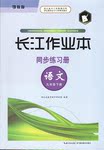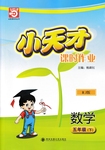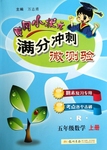


 长江作业本同步练习册系列答案
长江作业本同步练习册系列答案 小天才课时作业系列答案
小天才课时作业系列答案 一课四练系列答案
一课四练系列答案 黄冈小状元满分冲刺微测验系列答案
黄冈小状元满分冲刺微测验系列答案科目:高中英语 来源: 题型:阅读理解
Beijing had its biggest snowfall since 1951. Britain is suffering through its longest cold snap (寒潮) since 1981. And freezing weather is hitting the Deep South, including Florida’s orange groves and beaches.
Whatever happened to global warming?
Such weather doesn’t seem to fit with warnings from scientists that the Earth is warming because of greenhouse gases. But experts say the cold snap doesn’t contradict global warming at all—it’s just a temporary phenomenon in the long-term heating trend. “It’s part of natural variability,” said Gerald Meehl, a senior scientist. With global warming, he said, “we’ll still have record cold temperatures. We’ll just have fewer of them.”
Scientists say man-made climate change does have the potential to cause more frequent and more severe weather extremes. But experts did not connect the current cold snap to climate change.
So what is going on?
“We basically have seen just a big outbreak of Arctic air over populated areas of the Northern Hemisphere”, Arndt said.
In the atmosphere, large rivers of air travel roughly west to east around the globe between the Arctic and the tropics. This air flow acts like a fence to keep Arctic air restricted. But recently, this air flow has become bent into a zigzag (之字形) pattern, wandering north and south. If you live in a place where it brings air up from the south, you get warm weather. In fact, record highs were reported this week in Washington state and Alaska.
But in the eastern United States, like some other unlucky parts of the globe, Arctic air is coming from the north. And that’s how you get a temperature of 3 degrees in Beijing, a reading of minus-42 in mainland Norway, and 18 inches of snow in parts of Britain. The zigzag pattern arises naturally from time to time, but it is not clear why it’s so strong right now.
What is the best title of the text?
A. Freezing weather is hitting the Deep South.
B. We’ll still have record cold temperatures.
C. The air flow has become a zigzag pattern.
D. Cold snap doesn’t contradict global warming.
With global warming, we will ______.
A. also meet with severe cold snap
B. have more hot temperatures forever
C. never experience cold temperatures
D. have more cold temperatures
According to experts, the current cold snap ______.
A. suggests that the climate has changed greatly
B. is not related to the climate change
C. shows that the climate will turn cold
D. is affected by global warming
Beijing had its biggest snowfall since 1951 because of ______.
A. a fence from the Arctic B. a cooling trend in climate
C. a big outbreak of Arctic air D. its large population
We can conclude that ______.
A. not all the parts of the Northern Hemisphere are cold in face of the cold snap
B. the zigzag pattern arises naturally accidentally
C. Beijing will get cold weather next year
D. Washington state and Alaska will not face cold weather next year
查看答案和解析>>
科目:高中英语 来源: 题型:阅读理解
A gadget which makes water out of air could become the greatest household invention since the microwave. http://www..com/gaokao/beijing/
Using the same technology as a dehumidifier(除湿器),the Water Mill is able to create a ready supply of drinking water because it can always get it from an unlimited source—the air.http://www..com/gaokao/beijing/
The company behind the machine says not only does it offer an alternative to bottled water inhttp://www..com/gaokao/beijing/
developed countries, but it is a solution for the millions who face a daily water shortage.http://www..com/gaokao/beijing/
The machine works by drawing in wet air through a filter(过滤器)and over a cooling instrument which changes it into water droplets.It can produce up to 12 liters a day.The Water Mill will also produce more water when storms pass over, as the amount of water which is contained in the air increases. In keeping with its eco-development, the machine uses the same amount of electricity as three lights. Inventor Jonathan Ritchey said, “The demand for water is off the chart. So people are looking for freedom from water distribution systems that are shaky and unreliable.”
The machine, which is about 3 feet wide, is likely to cost £800 when it goes on sale here in the spring. Its maker, Canadian Firm Element Four, roughly calculates that a liter of water costs around 20 pence to produce.
Environmentalists state that half the world’s population will face water shortage because of climate change by 2080. One in five is said to lack access to safe drinking.
The Water Mill is not effective in areas where the amount of water contained in the air is below about 30 percent, but in Britain that won’t be much of a problem.
What does the underlined word “it” refer to?
A.Drinking water. B.Invention. C.Microwave. D.Water Mill.
What do we learn about the machine?
A.It works in the same way as microwaves.
B.It is very expensive for families to afford.
C.It absorbs wet air and turns it into water.
D.It helps to make the water clean to drink. http://www..com/gaokao/beijing/
What does the passage lead us to believe? http://www..com/gaokao/beijing/
A.The cost of water will go up. B.Bottled water will disappear soon.
C.The machine is energy saving. D.The machine will be popular worldwide.
What’s the best title for the passage? http://www..com/gaokao/beijing/
A.A New Way to Solve Water Problem. B.A Machine to Make Water out of Air.
C.A Dehumidifier to Produce Water. D.An Absolutely New Invention
查看答案和解析>>
科目:高中英语 来源: 题型:
The letter is from my sister, ______is working in Beijing.
A. which B. that C. whom D. who
查看答案和解析>>
科目:高中英语 来源: 题型:阅读理解
Limit the use of private cars, improve public transport and encourage the use of bicycles to control traffic congestion(拥挤) during the 2008 Olympics, experts from foreign countries advised Beijing on Friday.
Professor Nigel Wilson, of the civil and environmental engineering department of Massachusetts Institute of Technology, said he was "supportive to the limiting of private cars during the Olympic Games", saying that in foreign countries, the method is also adopted during big events, but he was unsure about the approach.
The government planned to keep an average of more than one million cars off the roads to improve traffic flow during the Olympics, said Liu Xiaoming, deputy director of the Beijing Traffic Committee, at the China Planning Network First Urban Transportation Congress.
Sharing Wilson's view, Dr. Yoshitsugu Hayashi, dean of the Graduate School of Environmental Studies of Nagoya University, believed the reduction in car use should be achieved not by banning, but through incentives.
"Drivers who don't use their private cars could be given points," he said, "and the points could be exchanged for goods from online shopping."
Wetzel stressed limiting the use of company cars. "Governmental officials should also be encouraged to use public transportation or ride bicycles," he said, adding that he himself is a bicycle-rider in London.
Matthew Martimo, director of Traffic Engineering with Citilabs, said the bicycle was China's advantage. "Limiting private cars is an idea worth trying but it is just a temporary solution," he said. "The real cause of congestion is high density of people in Beijing and many have cars."
Beijing, with a population of 15 million, is home to more than three million automobiles, and the number is rising by 1,000 a day.
Professor Wilson said the Olympic Games was a great opportunity for Beijing to think about traffic problems and develop transportation, adding that the city had already been making public transport more efficient. Beijing has promised to stretch its 114-kilometer city railway to 200 kilometers before the opening of the Olympic Games.
“We are looking forward to borrowing Beijing's experiences and drawing from its lessons in preparation for the 2012 Olympics,” said Wetzel.
51. The underlined word incentives in paragraph 4 means_______.
A. something that encourages people to try B. online shopping
C. points could be exchanged for goods D. award
52.It can be seen from the passage that ______.
A. the government planned to forbid over 1 million cars to run on the roads during the Olympics.
B. banning private cars is the best way to solve traffic congestion in Beijing
C. Beijing now has 200 kilometers of city railway
D. the use of company cars will not be limited
53. Why did Wetzel stress “ he himself is a bicycle-rider in London”?
A. To limit the use of company cars.
B. To encourage governmental officials to use public transportation or ride bicycles.
C. To show that riding bicycles is good for health.
D. To show that he loves riding bicycles.
54. Which of the following may be the reason for the traffic congestion in Beijing?
A. The 2008 Beijing Olympic games.
B. The number of cars in Beijing is rising by 1,000 a day.
C. The large population in Beijing and the large number of cars.
D. Public transport in Beijing is not efficient.
55. The purpose of the passage is ________.
A. to limit the use of private cars, improve public transport
B. to encourage the use of bicycles to control traffic congestion during the 2008 Olympics
C. to borrow Beijing's experiences and draw from its lessons in preparation for the 2012 Olympics
D. to tell the advice given by foreign experts on traffic congestion during 2008 Beijing Olympics
查看答案和解析>>
科目:高中英语 来源:江苏省09-10学年度高一下学期模快练习(三) 题型:单项填空
16.By the end of last year, another new gymnasium _____ in Beijing.
|
A.would be completed |
B.was being completed |
|
C.had been completed |
D.has been completed |
查看答案和解析>>
湖北省互联网违法和不良信息举报平台 | 网上有害信息举报专区 | 电信诈骗举报专区 | 涉历史虚无主义有害信息举报专区 | 涉企侵权举报专区
违法和不良信息举报电话:027-86699610 举报邮箱:58377363@163.com